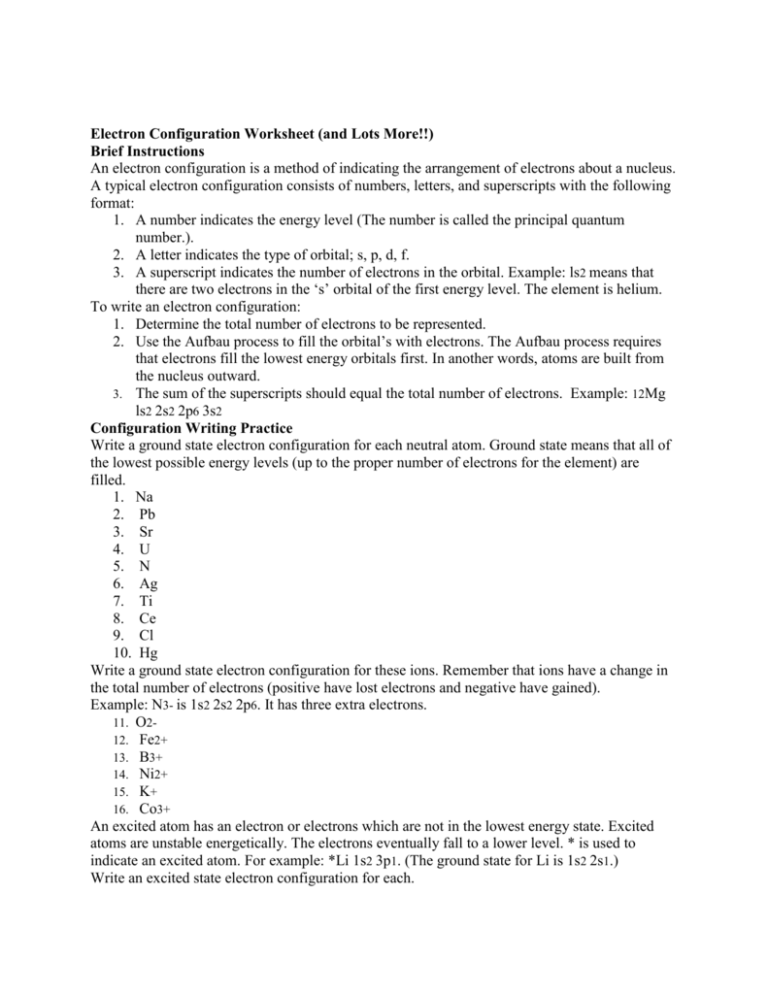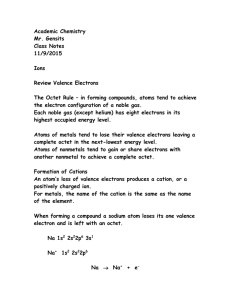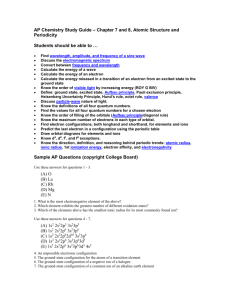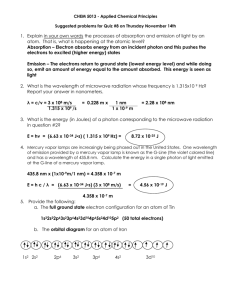Electron Configuration Worksheet
advertisement

Electron Configuration Worksheet (and Lots More!!) Brief Instructions An electron configuration is a method of indicating the arrangement of electrons about a nucleus. A typical electron configuration consists of numbers, letters, and superscripts with the following format: 1. A number indicates the energy level (The number is called the principal quantum number.). 2. A letter indicates the type of orbital; s, p, d, f. 3. A superscript indicates the number of electrons in the orbital. Example: ls2 means that there are two electrons in the ‘s’ orbital of the first energy level. The element is helium. To write an electron configuration: 1. Determine the total number of electrons to be represented. 2. Use the Aufbau process to fill the orbital’s with electrons. The Aufbau process requires that electrons fill the lowest energy orbitals first. In another words, atoms are built from the nucleus outward. 3. The sum of the superscripts should equal the total number of electrons. Example: 12Mg ls2 2s2 2p6 3s2 Configuration Writing Practice Write a ground state electron configuration for each neutral atom. Ground state means that all of the lowest possible energy levels (up to the proper number of electrons for the element) are filled. 1. Na 2. Pb 3. Sr 4. U 5. N 6. Ag 7. Ti 8. Ce 9. Cl 10. Hg Write a ground state electron configuration for these ions. Remember that ions have a change in the total number of electrons (positive have lost electrons and negative have gained). Example: N3- is 1s2 2s2 2p6. It has three extra electrons. 11. O212. Fe2+ 13. B3+ 14. Ni2+ 15. K+ 16. Co3+ An excited atom has an electron or electrons which are not in the lowest energy state. Excited atoms are unstable energetically. The electrons eventually fall to a lower level. * is used to indicate an excited atom. For example: *Li 1s2 3p1. (The ground state for Li is 1s2 2s1.) Write an excited state electron configuration for each. 17. Al 18. Ar 19. K 20. C 21. If each orbital can hold a maximum of two electrons, how many electrons can each of the following hold? a. 2s b. 5p c. 4f d. 3d e. 4d 22. What is the shape of an s orbital? 23. How many s orbitals can there be in an energy level? 24. How many electrons can occupy an s orbital? 25. What is the shape of a p orbital? 26. How many p orbitals can there be in an energy level? 27. Which is the lowest energy level that can have a s orbital? 28. Which is the lowest energy level that can have a p orbital? 29. Is it possible for two electrons in the same atom to have exactly the same set of quantum numbers? 30. Distinguish between an atom in its ground state and an excited atom. 31. How many d orbitals can there be in an energy level? 32. How many d electrons can there be in an energy level? 33. Which is the lowest energy level having d orbitals? 34. How many f electrons can there be in an energy level? 35. Which is the lowest energy level having f orbitals? 36. How many f orbitals can there be in an energy level? 37. How many energy levels are partially or fully ocupied in a neutral atom of calcium? 38. Why do the fourth and fifth series of elements contain 18 elements, rather than 8 as do the second and third series? 39. Which sublevels of the 3rd energy level are filled (a) in the element argon (b) in the element krypton? 40. Why does it take more energy to remove an electron from Al+ than from Al? 41. What does the term principal quantum number refer to? 42. What is meant by the electron configuration of an atom? 43. What is the maximum number of electrons that can be present in an atom having three principal energy levels? 44. Which of the following notations shows the electron configuration of a neutral atom in an excited state? Name the element, and explain how you know it is excited: a. 1s2 2s22p1 b. 1s2 2s22p3 3s1 c. 1s2 2s22p6 3s2 3p1 45. Isoelectronic species have similar electron configurations. Which of these are isoelectronic? (a) Li+, H-, He (b) Ca2+, Ne, S246. For the following elements list the electron configuration. If these is no charge listed, assume it is neutral. a. oxygen b. cesium c. krypton d. Titanium e. scandium f. g. h. nitrogen chlorine fluorine1i. arsenic j. francium k. selenium3l. copper1+ m. potassium2n. antimony2+ o. thorium1p. mercury2+ 47. For the following elements list the shorthand electron configuration a. boron b. cadmium c. phosphorus d. neon e. radon f. iodine g. strontium h. chromium3+ i. nickel j. iron k. astanine l. molybedenum2m. rubidium3n. bromine1+ o. xenon p. europium3+ 48. For the following electron configurations choose 3 possible elements (or ions) they may represent a. 1s2 2s22p6 3s23p6 4s2 3d10 4p4 b. 1s2 2s22p6 3s23p6 4s2 3d10 4p5 c. 1s2 2s22p6 3s23p6 4s2 3d10 4p6 d. 1s2 2s22p6 3s23p6 4s2 3d10 4p6 5s2 4d10 5p6 6s2 4f14 5d10 6p6 7s1 e. 1s2 2s22p6 3s23p6 4s2 3d10 4p6 5s24 d10 5p6 6s2 4f14 5d10 6p6 7s2 5f14 6d8 f. 1s2 2s22p6 3s23p6 4s2 3d10 4p6 5s2 4d10 5p6 6s2 4f10 g. 1s2 2s22p6 3s23p6 4s2 3d10 4p6 5s2 4d10 5p6 6s2 4f14 5d10 6p4 h. 1s2 2s22p6 3s23p6 4s2 3d5 i. 1s2 2s22p6 3s23p6 4s2 3d10 4p6 5s2 4d10 5p2 j. [Kr] 5s2 4d10 5p3 k. [Kr] 5s2 4d10 5p6 l. [Ar] 4s1 m. [Xe] 6s2 4f10 n. [Xe] 6s2 4f14 5d7 o. [Ne] 3s2 3p1 Writing Electron Configurations 1. Electrons occupy the lowest energy orbital first, and then move to the next one and so on. (The "Aufbau" Princple) 2. Orbital’s are considered to be in the same shell if they have the same first number (no matter in what order filling is done). 3. An atom will gain or lose electrons in order to have eight electrons in its outer shell. (The "Octet" Rule) 4. The outer shell is the highest numbered shell which has electrons in it. Only s and p orbital’s are part of the outer shell. An atom has the tendency to lose electrons (to another atom) or to gain electrons (from another atom) in order to make the outer shell complete with eight electrons. Atoms with a complete outer shell (eight electrons) are considered stable. Some atoms naturally have eight electrons in their outer shell and are very stable. (Helium is the exception being stable with two electrons in its outer shell.) Complete the following chart:







